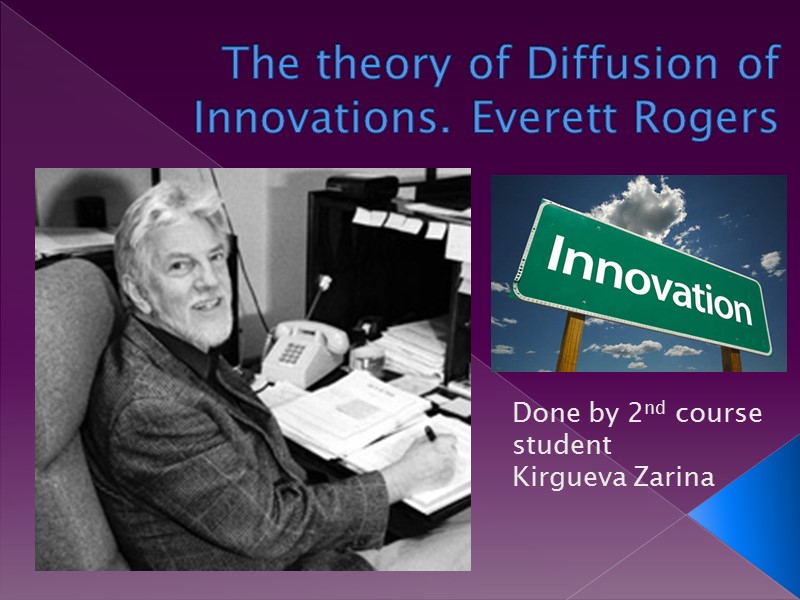 The theory of Diffusion of Innovations. Everett Rogers Done by 2nd course student Kirgueva Zarina
The theory of Diffusion of Innovations. Everett Rogers Done by 2nd course student Kirgueva Zarina
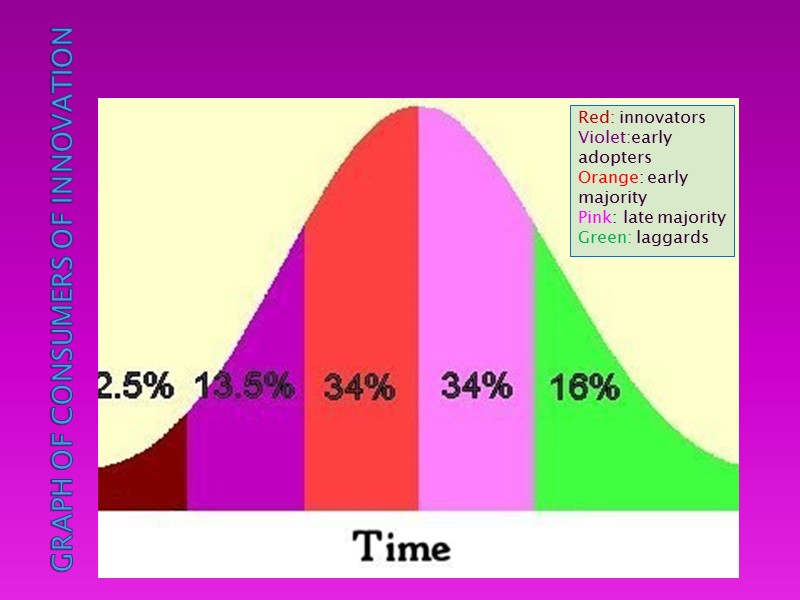 The biography of Everett Rogers Everett M. Rogers (March 6, 1931 - October 21, 2004) was a scientist, sociologist, and teacher. In 1957, he received his doctorate in philosophy and sociology. In 1962, Everett Rogers offered so-called theory of diffusion of innovations.
The biography of Everett Rogers Everett M. Rogers (March 6, 1931 - October 21, 2004) was a scientist, sociologist, and teacher. In 1957, he received his doctorate in philosophy and sociology. In 1962, Everett Rogers offered so-called theory of diffusion of innovations.
 The last edition of the book The Theory of Diffusion of Innovations was first published in 1962. You can see the fifths(last) edition(2003) of the book on the left picture and Everett Rogers on the right picture.
The last edition of the book The Theory of Diffusion of Innovations was first published in 1962. You can see the fifths(last) edition(2003) of the book on the left picture and Everett Rogers on the right picture.
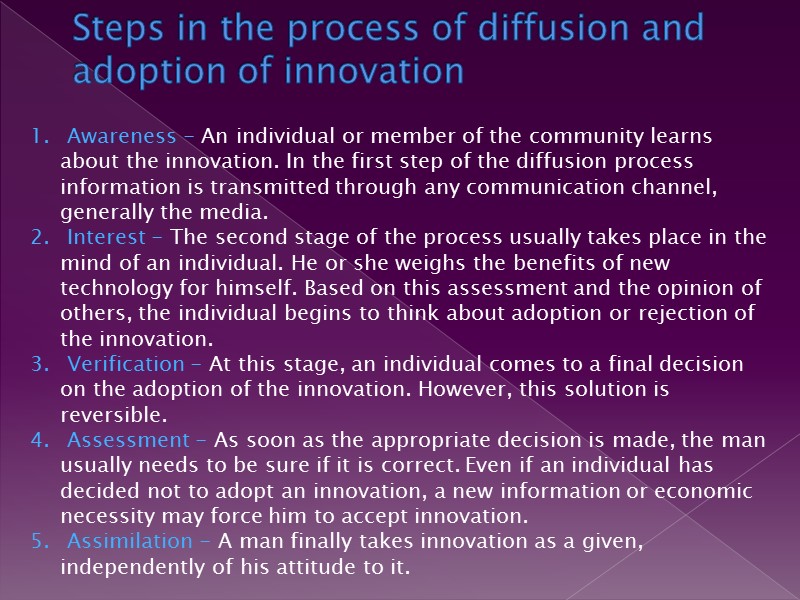 The Theory of Diffusion of Innovations Diffusion of innovation – is a process of spreading new products or ideas in society and its distribution patterns among consumers. Called so by analogy with diffusion in Physics. Basis of the theory is segmentation of potentional consumers into five groups.
The Theory of Diffusion of Innovations Diffusion of innovation – is a process of spreading new products or ideas in society and its distribution patterns among consumers. Called so by analogy with diffusion in Physics. Basis of the theory is segmentation of potentional consumers into five groups.
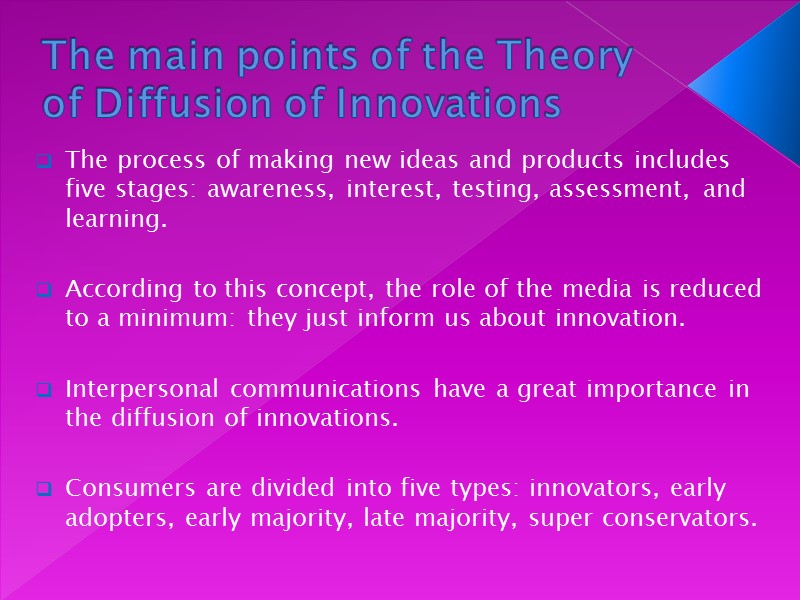 Adopters of innovations. Innovators. Innovators – the first consumers adopting a new product. 2,5% of target market.
Adopters of innovations. Innovators. Innovators – the first consumers adopting a new product. 2,5% of target market.
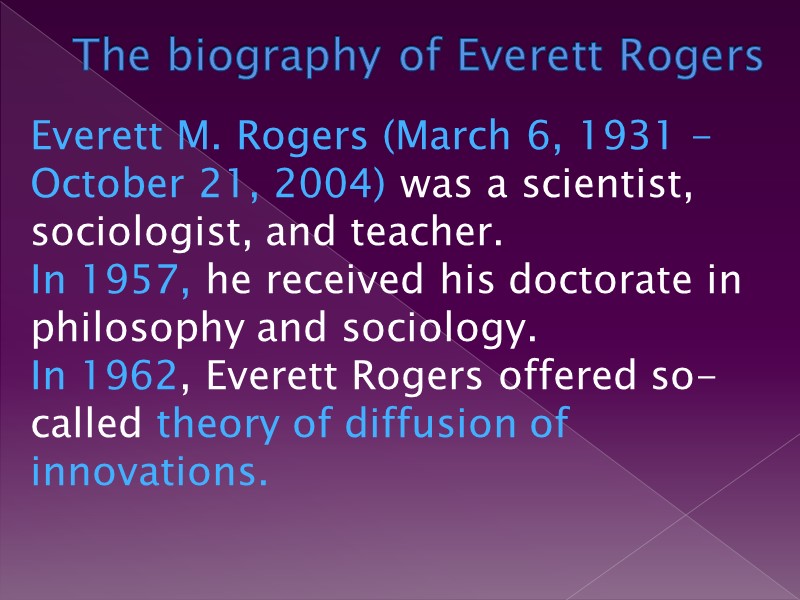 Adopters of innovations. Early Adopters. Early Adopters - They adopt new ideas, shape public opinion, but they are not very risky. 13,5% of target market.
Adopters of innovations. Early Adopters. Early Adopters - They adopt new ideas, shape public opinion, but they are not very risky. 13,5% of target market.
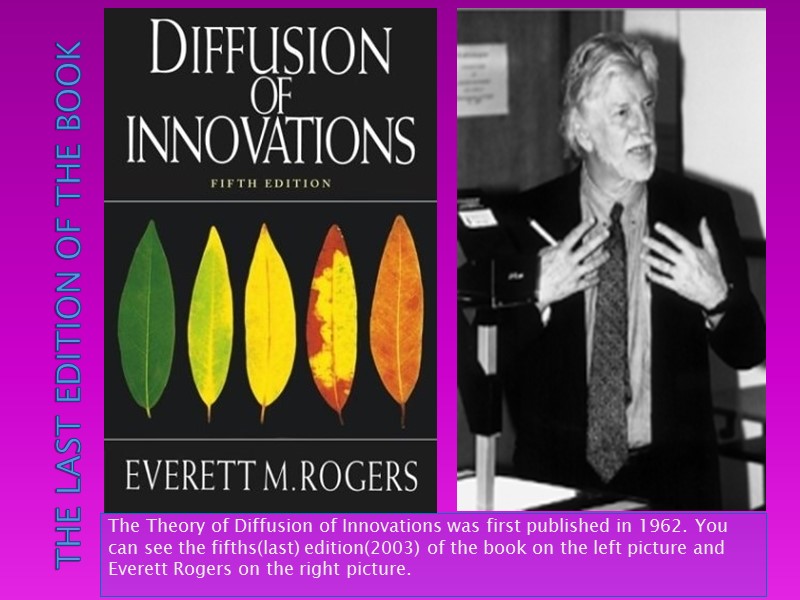 Adopters of innovations. Early Majority Early Majority – the first part of mass consumers. 34% of target market.
Adopters of innovations. Early Majority Early Majority – the first part of mass consumers. 34% of target market.
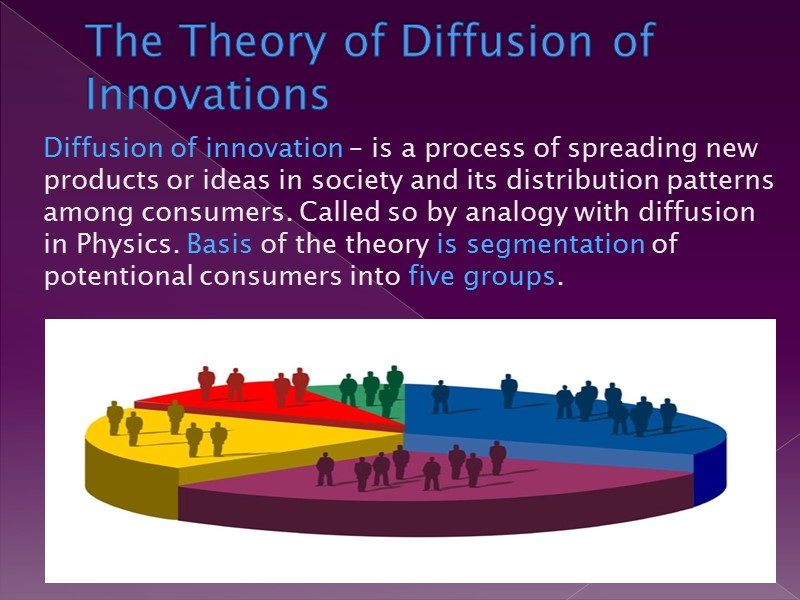 Adopters of innovations. Late Majority Late Majority – the second part of mass consumers. 34% of target market.
Adopters of innovations. Late Majority Late Majority – the second part of mass consumers. 34% of target market.
 Adopters of innovations. Super conservators(Laggards). Super conservators (Laggards) – adopt the innovation lately than others. 16% of target market.
Adopters of innovations. Super conservators(Laggards). Super conservators (Laggards) – adopt the innovation lately than others. 16% of target market.
 Graph of consumers of innovation Red: innovators Violet:early adopters Оrange: early majority Рink: late majority Green: laggards
Graph of consumers of innovation Red: innovators Violet:early adopters Оrange: early majority Рink: late majority Green: laggards
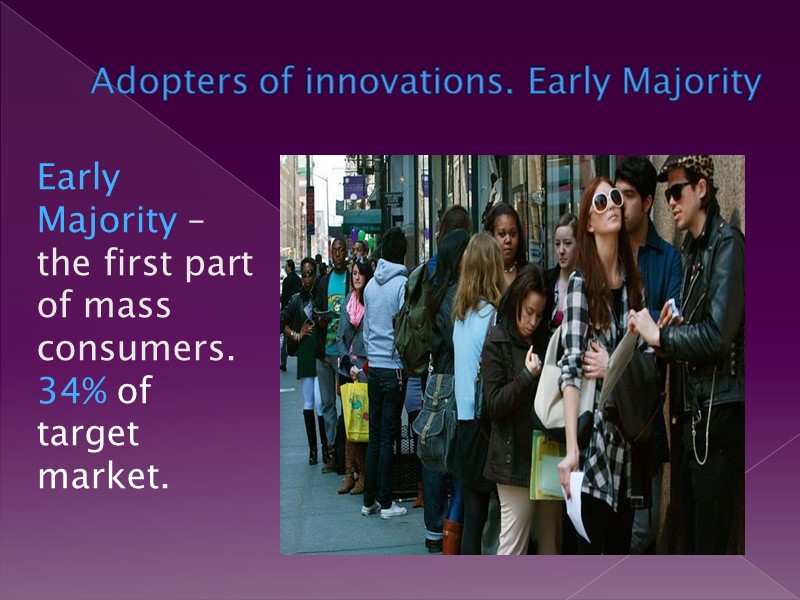 Процессы распространения и принятия инновации Исследования показали, что осведомленность о новшествах распространяется по СМИ гораздо быстрее, чем при межличностном общении. Выделяются пять ключевых этапов, которыми практически исчерпывается процесс диффузии инноваций: Осведомленность Интерес Проверка Оценка Усвоение
Процессы распространения и принятия инновации Исследования показали, что осведомленность о новшествах распространяется по СМИ гораздо быстрее, чем при межличностном общении. Выделяются пять ключевых этапов, которыми практически исчерпывается процесс диффузии инноваций: Осведомленность Интерес Проверка Оценка Усвоение
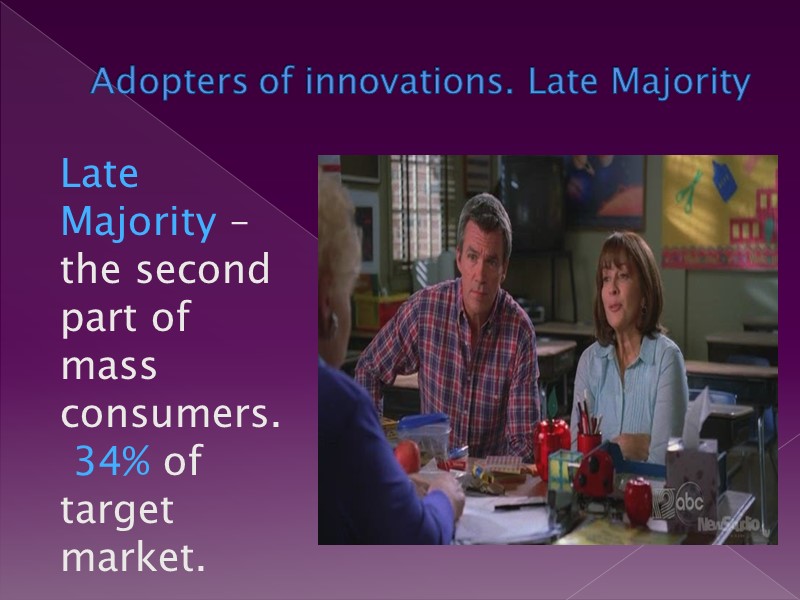 Steps in the process of diffusion and adoption of innovation Awareness - An individual or member of the community learns about the innovation. In the first step of the diffusion process information is transmitted through any communication channel, generally the media. Interest - The second stage of the process usually takes place in the mind of an individual. He or she weighs the benefits of new technology for himself. Based on this assessment and the opinion of others, the individual begins to think about adoption or rejection of the innovation. Verification - At this stage, an individual comes to a final decision on the adoption of the innovation. However, this solution is reversible. Assessment - As soon as the appropriate decision is made, the man usually needs to be sure if it is correct. Even if an individual has decided not to adopt an innovation, a new information or economic necessity may force him to accept innovation. Assimilation - A man finally takes innovation as a given, independently of his attitude to it.
Steps in the process of diffusion and adoption of innovation Awareness - An individual or member of the community learns about the innovation. In the first step of the diffusion process information is transmitted through any communication channel, generally the media. Interest - The second stage of the process usually takes place in the mind of an individual. He or she weighs the benefits of new technology for himself. Based on this assessment and the opinion of others, the individual begins to think about adoption or rejection of the innovation. Verification - At this stage, an individual comes to a final decision on the adoption of the innovation. However, this solution is reversible. Assessment - As soon as the appropriate decision is made, the man usually needs to be sure if it is correct. Even if an individual has decided not to adopt an innovation, a new information or economic necessity may force him to accept innovation. Assimilation - A man finally takes innovation as a given, independently of his attitude to it.
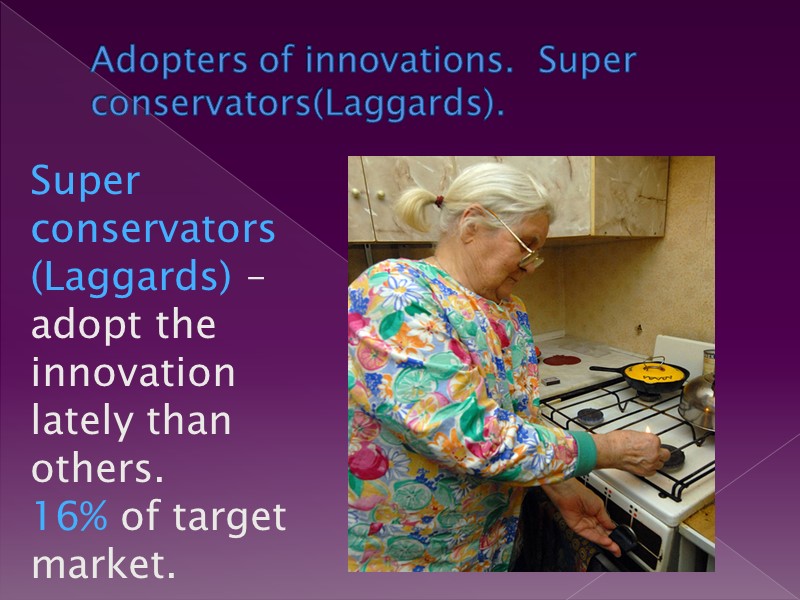 The main points of the Theory of Diffusion of Innovations The process of making new ideas and products includes five stages: awareness, interest, testing, assessment, and learning. According to this concept, the role of the media is reduced to a minimum: they just inform us about innovation. Interpersonal communications have a great importance in the diffusion of innovations. Consumers are divided into five types: innovators, early adopters, early majority, late majority, super conservators.
The main points of the Theory of Diffusion of Innovations The process of making new ideas and products includes five stages: awareness, interest, testing, assessment, and learning. According to this concept, the role of the media is reduced to a minimum: they just inform us about innovation. Interpersonal communications have a great importance in the diffusion of innovations. Consumers are divided into five types: innovators, early adopters, early majority, late majority, super conservators.

























